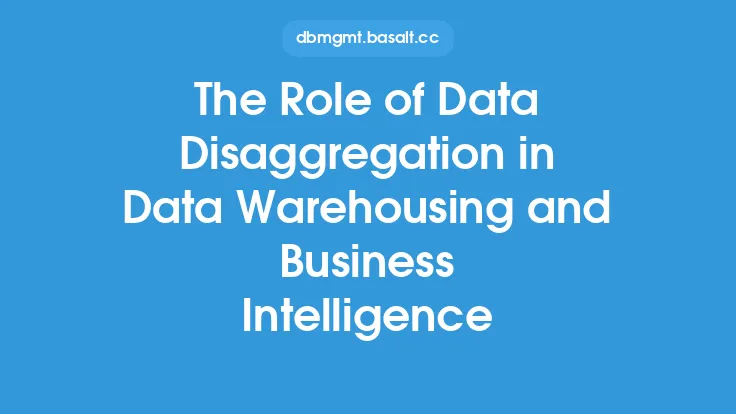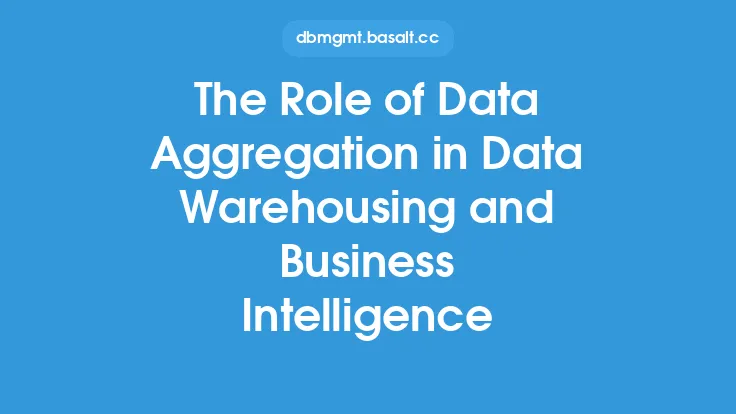In today's fast-paced business environment, organizations are constantly seeking ways to gain a competitive edge and make informed decisions. One crucial aspect of achieving this goal is the effective management and analysis of data. Data warehousing plays a vital role in this process, serving as a central repository for storing and managing large amounts of data from various sources. By leveraging data warehousing, businesses can unlock the full potential of their data, driving business intelligence and informing strategic decisions.
Introduction to Data Warehousing
Data warehousing is a process that involves collecting, storing, and managing data from multiple sources in a single, unified repository. This repository, known as a data warehouse, provides a centralized location for data analysis, reporting, and business intelligence. Data warehouses are designed to support business decision-making by providing a comprehensive view of an organization's data, enabling users to analyze and extract insights from the data. The primary goal of a data warehouse is to provide a single, trusted source of data that can be used to support business intelligence and decision-making.
Data Warehousing Architecture
A typical data warehousing architecture consists of several components, including data sources, data integration tools, a data warehouse, and business intelligence tools. Data sources can include various systems, such as customer relationship management (CRM) systems, enterprise resource planning (ERP) systems, and social media platforms. Data integration tools are used to extract, transform, and load (ETL) data from these sources into the data warehouse. The data warehouse itself is typically a relational database management system (RDBMS) or a column-store database, designed to support fast query performance and large data volumes. Business intelligence tools, such as reporting and analytics software, are used to access and analyze the data in the data warehouse.
Benefits of Data Warehousing
The benefits of data warehousing are numerous and well-documented. By providing a centralized repository for data, data warehousing enables organizations to consolidate and standardize their data, reducing data redundancy and improving data quality. Data warehousing also enables faster query performance, as data is optimized for querying and analysis. Additionally, data warehousing provides a single, trusted source of data, enabling users to make informed decisions based on accurate and up-to-date information. Other benefits of data warehousing include improved data security, enhanced data governance, and increased scalability.
Data Warehousing and Business Intelligence
Data warehousing is a critical component of business intelligence, as it provides the foundation for data analysis and reporting. By leveraging data warehousing, organizations can create a business intelligence framework that supports decision-making at all levels of the organization. Business intelligence tools, such as dashboards and scorecards, can be used to access and analyze data in the data warehouse, providing users with real-time insights and trends. Data warehousing also enables organizations to create data visualizations, such as charts and graphs, to help communicate complex data insights to stakeholders.
Data Warehousing Design Considerations
When designing a data warehouse, several factors must be considered to ensure that the system meets the needs of the organization. These factors include data volume, data complexity, and query patterns. Data volume refers to the amount of data that will be stored in the data warehouse, while data complexity refers to the number of data sources and the complexity of the data itself. Query patterns refer to the types of queries that will be executed against the data warehouse, such as ad-hoc queries or batch reports. Other design considerations include data governance, data security, and scalability.
Data Warehousing Technologies
Several technologies are available to support data warehousing, including relational database management systems (RDBMS), column-store databases, and NoSQL databases. RDBMS, such as Oracle and Microsoft SQL Server, are traditional data warehousing platforms that support fast query performance and large data volumes. Column-store databases, such as Apache Cassandra and Amazon Redshift, are optimized for fast query performance and are often used in big data analytics applications. NoSQL databases, such as MongoDB and Couchbase, are flexible and scalable data storage solutions that support a variety of data formats and structures.
Best Practices for Data Warehousing
To ensure the success of a data warehousing project, several best practices must be followed. These best practices include defining clear business requirements, designing a scalable architecture, and implementing robust data governance policies. Clear business requirements are essential to ensure that the data warehouse meets the needs of the organization, while a scalable architecture ensures that the system can grow and adapt to changing business needs. Robust data governance policies are necessary to ensure data quality, security, and compliance with regulatory requirements. Other best practices include monitoring and optimizing system performance, providing training and support to users, and continuously evaluating and improving the data warehousing system.
Conclusion
In conclusion, data warehousing is a critical component of business intelligence, providing a centralized repository for storing and managing large amounts of data from various sources. By leveraging data warehousing, organizations can unlock the full potential of their data, driving business intelligence and informing strategic decisions. When designing a data warehouse, several factors must be considered, including data volume, data complexity, and query patterns. By following best practices and leveraging the right technologies, organizations can create a scalable and flexible data warehousing system that supports business decision-making and drives business success.





